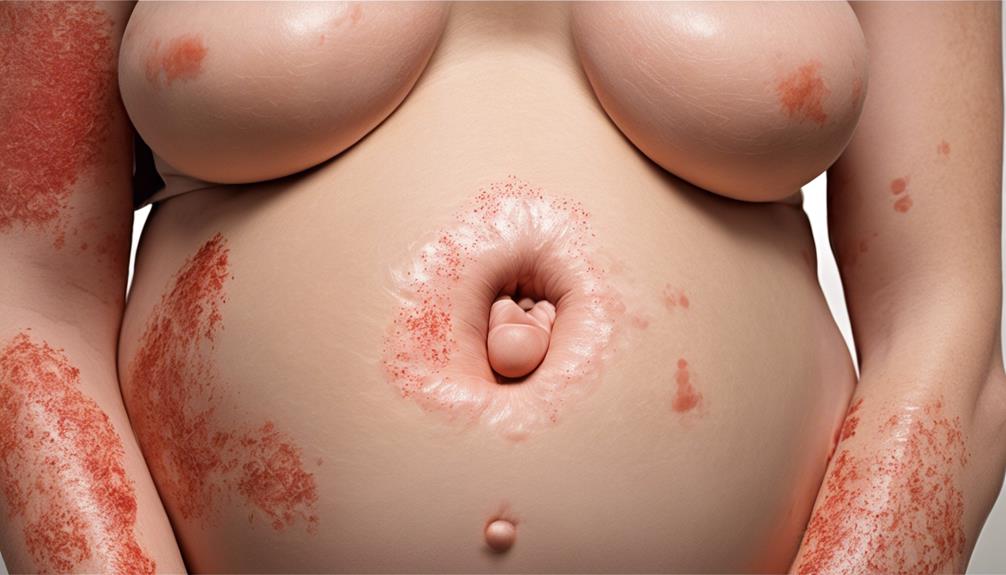During pregnancy, it is important to be aware that rashes can emerge in the second trimester. Navigating the complexities of pregnancy and dealing with different skin problems can be confusing and alarming.
However, understanding the nuances of these common rashes that may manifest during this critical period could provide invaluable insights into ensuring maternal well-being. Let's explore these five distinctive rashes, shedding light on their characteristics and implications to equip ourselves with knowledge for a smoother journey ahead.
Key Takeaways
- Prurigo of Pregnancy & Atopic Eruption are common, itchy skin conditions in pregnancy.
- Pemphigoid Gestationis is rare but requires monitoring and corticosteroid treatment.
- Polymorphic Eruption causes severe itching but is manageable with antihistamines and steroids.
- Cholestasis of Pregnancy, a liver condition, needs close monitoring and may require induction of labor.
Prurigo Of Pregnancy: Symptoms & Causes
During pregnancy's second trimester, experiencing Prurigo of Pregnancy can be characterized by the development of itchy, discolored bumps on the skin. This rash, often mistaken for bug bites or acne, typically appears on body parts like the backs of elbows or knees. It can manifest in shades of pink, red, or purple, sometimes being crusty or scaly.
Fortunately, Prurigo of Pregnancy usually doesn't pose risks to the baby. This condition is part of the atopic eruption of pregnancy, affecting about 1 in 300 pregnancies. The exact causes of Prurigo of Pregnancy aren't entirely clear, but hormonal changes, increased sensitivity of the skin, and immune system variations during pregnancy are thought to play a role.
It's essential to consult healthcare professionals for proper diagnosis and management of this rash to make sure the well-being of both the mother and the baby.
Atopic Eruption of Pregnancy Overview
Prurigo of Pregnancy, a common rash during the second trimester, is part of a group of pregnancy-related skin conditions known as Atopic Eruption of Pregnancy (AEP).
AEP encompasses various conditions like eczema, prurigo, and pruritic folliculitis that can occur during pregnancy. These conditions typically manifest in the late second or early third trimester, affecting about half of pregnancy-related skin issues.
Symptoms of AEP include itchy, dry, and scaly skin patches that can appear in different areas of the body. Thankfully, treatments such as topical medications and antihistamines can help manage these uncomfortable symptoms.
The good news is that AEP is generally harmless to both the mother and the baby, and symptoms often improve after delivery, bringing relief to many expecting mothers.
If you're experiencing itchy skin during your pregnancy's second trimester, know that you're not alone, and there are ways to ease your discomfort.
Pemphigoid Gestationis: Diagnosis & Management
Diagnosis and management of pemphigoid gestationis, a rare autoimmune skin condition affecting about 1 in 50,000 pregnancies, involve skin biopsies, blood tests, and sometimes direct immunofluorescence studies. These steps are critical in confirming the diagnosis and determining the best course of action for treatment. Skin biopsies help in identifying the characteristic changes in the skin layers, while blood tests can reveal specific antibodies associated with the condition. Direct immunofluorescence studies aid in detecting immune system activity in the skin.
| Diagnostic Method | Purpose | Frequency |
|---|---|---|
| Skin Biopsies | Identify skin changes specific to pemphigoid gestationis | Once for confirmation |
| Blood Tests | Detect antibodies related to the condition | Periodic monitoring |
| Direct Immunofluorescence | Determine immune system activity in the skin | Initially for confirmation |
Management of pemphigoid gestationis often includes oral corticosteroids to control symptoms and prevent complications. Monitoring closely for any signs of premature birth or low birth weight is critical, as pemphigoid gestationis can increase these risks. Recurrence in subsequent pregnancies is possible, necessitating ongoing monitoring and management to guarantee the best outcomes for both the mother and the baby.
Polymorphic Eruption of Pregnancy Insights

In the management of Polymorphic Eruption of Pregnancy (PEP), healthcare providers commonly recommend oral antihistamines and steroids to alleviate symptoms and promote maternal comfort. PEP, affecting approximately 1 in 160 pregnancies, typically presents as a severely itchy rash on the abdomen during the third trimester. While discomfort can be significant, the good news is that PEP doesn't pose lasting harm to either the mother or the fetus.
Here are some insights into dealing with PEP:
- Symptom Relief: Oral antihistamines can help reduce itching, providing much-needed relief for expectant mothers.
- Medical Consultation: It's essential to consult with healthcare providers promptly if experiencing symptoms of PEP.
- Steroid Therapy: In more severe cases, doctors may prescribe steroids to manage the rash and itching effectively.
- Monitoring: Regular monitoring and follow-ups with healthcare professionals are essential during treatment.
- Self-Care: Alongside medical interventions, maintaining good skincare practices and staying hydrated can aid in managing PEP symptoms effectively.
Cholestasis of Pregnancy: Treatment Options
Cholestasis of pregnancy, a liver condition stemming from hormonal changes impacting bile flow, offers various treatment options to alleviate symptoms and guarantee maternal well-being. When experiencing intense itching and jaundice, a blood test can confirm the diagnosis by evaluating liver function and bile acid levels.
Treatment may involve oral medications to relieve symptoms and potentially induce labor in severe cases to prevent complications. It's essential to monitor the condition closely, as cholestasis of pregnancy typically resolves after delivery, with symptoms improving postpartum. If diagnosed with this liver condition during pregnancy, consulting healthcare providers promptly is essential for proper management.
Frequently Asked Questions
Can Common Rashes During the Second Trimester of Pregnancy Affect the Health of the Baby?
Common rashes during the second trimester of pregnancy can sometimes impact the baby's health. Consultation with a healthcare provider for proper evaluation and guidance is necessary. Early detection and management are vital for the well-being of both mother and baby.
Are There Any Home Remedies or Over-The-Counter Treatments That Are Safe to Use for Common Rashes During Pregnancy?
When dealing with common rashes during pregnancy, it is crucial to seek safe home remedies or over-the-counter treatments. Consult your healthcare provider for options such as oatmeal baths, calamine lotion, or mild hydrocortisone creams for relief.
How Long Do Common Rashes During Pregnancy Typically Last, and Will They Go Away on Their Own After Giving Birth?
Typically, common rashes during pregnancy can last varying durations. Some may resolve postpartum, while others may persist. It's important to consult healthcare providers for accurate diagnosis and tailored treatment plans to manage these conditions effectively.
Are There Any Specific Triggers or Factors That Can Worsen Common Rashes During Pregnancy During the Second Trimester?
Through stress, hormonal changes, and allergies, common rashes during pregnancy's second trimester can worsen. Identifying triggers like certain foods, skincare products, or environmental factors is key to managing discomfort and seeking appropriate care.
Are There Any Long-Term Effects or Complications Associated With Common Rashes During Pregnancy That Women Should Be Aware Of?
Long-term effects or complications from common pregnancy rashes can vary. It's important to seek medical guidance to address concerns promptly. Ensuring proper diagnosis and treatment will aid in managing any potential risks for both mother and baby.
Conclusion
To sum up, experiencing common rashes during pregnancy's second trimester can be a challenging but manageable aspect of this special time. While these skin conditions may cause discomfort, seeking medical advice and treatment can help guarantee symptoms and ensure a smooth pregnancy journey.
Remember, even though these rashes may be itchy and irritating, they're usually harmless and temporary nuisances in the grand scheme of bringing new life into the world.










